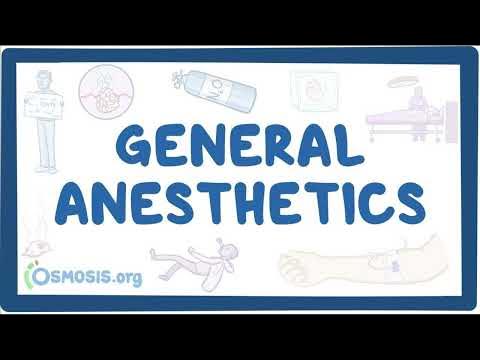What did people do before anesthesia? - Sally Frampton
Summary
TLDRThe video explores the evolution of surgical anesthetics, from early methods like alcohol mixtures in 200 CE to the breakthrough use of ether, nitrous oxide, and chloroform in the 19th century. Surgeons like Robert Liston prioritized speed before anesthetics, as patients had to endure conscious pain. Over time, discoveries in anesthetics enabled more complex, precise surgeries. While ether and nitrous oxide are still used in safer forms today, chloroform fell out of favor due to its toxic effects. These advancements transformed surgery from a painful ordeal into a dreamlike experience.
Takeaways
- 🔪 Robert Liston was a renowned Scottish surgeon in the 1830s, famous for his surgical speed, which was crucial before anesthesia.
- 😷 Before anesthesia, patients had to endure surgery while fully conscious, making speed a vital factor in minimizing suffering.
- 🌿 The quest for anesthetics began centuries ago, with early methods like Chinese physician Hua Tuo’s alcohol and herbal mixtures in 200 CE.
- 💊 13th century Arab surgeon Ibn al-Quff used inhalation-based anesthetics, including drugs like cannabis, opium, and mandrake.
- 🎈 In 1799, English chemist Humphry Davy experimented with nitrous oxide (laughing gas), noting its pain-relieving potential, though it wasn’t widely used immediately.
- 🌸 Japanese surgeon Seishū Hanaoka successfully used a mix of medicinal herbs to anesthetize a patient in 1804, though the news remained isolated in Japan.
- ⚗️ Ether, after centuries of recreational use, became more prominent in surgery during the 1800s, starting with successful tumor removals.
- 🦷 Nitrous oxide gained recognition in dentistry, though an 1845 public tooth extraction failure due to insufficient dosage gave it bad publicity.
- 💤 Ether gained attention with successful surgeries, including Robert Liston’s 1846 leg amputation on an etherized patient, who regained consciousness soon after.
- ⛔ Chloroform, popularized by James Simpson in 1847, became widely used but was later found to be harmful and carcinogenic.
Q & A
Who was Robert Liston, and why was he renowned as a surgeon in the 1830s?
-Robert Liston was a Scottish surgeon in the 1830s, renowned for his surgical speed. His rapid surgical methods were crucial during a time when anesthesia was not yet widely used, forcing patients to endure surgery consciously.
Why was surgical speed important before anesthesia was widely used?
-Before anesthesia was widely used, patients remained conscious during surgery, making the procedure extremely painful. Speed was essential to minimize the patient's suffering.
What were some early methods of anesthesia used before modern anesthetics?
-Some early methods included the use of alcohol mixed with medicinal powders by Chinese physician Hua Tuo (around 200 CE) and the inhalation of substances like cannabis, opium, and mandrake by Arab surgeon Ibn al-Quff in the 13th century.
Which three key substances played a major role in the development of modern anesthetics?
-The three key substances were nitrous oxide, ether, and chloroform, each of which had varying levels of effectiveness and safety.
How did English chemist Humphry Davy contribute to the development of nitrous oxide as an anesthetic?
-In 1799, Humphry Davy experimented with nitrous oxide, noting its pain-relieving properties and suggesting it could be useful for surgery. However, it took decades before it was applied in medical settings.
What role did ether play in the early 19th-century development of anesthesia?
-Ether was first used recreationally in 'ether frolics,' but its pain-numbing effects were later discovered by American physicians. In 1842, ether was successfully used in surgery to remove a neck tumor, marking a significant advancement in anesthesia.
Why did nitrous oxide have a setback in its initial public demonstrations as an anesthetic?
-Nitrous oxide faced a setback in 1845 when an American dentist attempted a public tooth extraction using it, but the patient screamed, likely due to an insufficient dose, leading to negative publicity.
How did chloroform gain popularity, and what issues arose with its use?
-Chloroform gained popularity after Scottish obstetrician James Simpson used it in childbirth, appreciating its fast-acting effects. However, it was later discovered to be toxic and possibly carcinogenic, leading to its decline by the early 1900s.
How did beliefs about gender and race affect the administration of anesthesia in the 19th century?
-Some doctors, like Charles Meigs, believed that women, especially during childbirth, should endure pain as a form of divine suffering. Additionally, American physician James Marion Sims conducted painful gynecological experiments on enslaved Black women without anesthesia.
How has anesthesia evolved from the 19th century to today?
-Anesthesia has evolved from toxic and inconsistent substances like chloroform and early formulations of ether and nitrous oxide to safer, modified drugs that allow for complex surgeries with fewer side effects. Patients are now carefully monitored to ensure safety.
Outlines

Cette section est réservée aux utilisateurs payants. Améliorez votre compte pour accéder à cette section.
Améliorer maintenantMindmap

Cette section est réservée aux utilisateurs payants. Améliorez votre compte pour accéder à cette section.
Améliorer maintenantKeywords

Cette section est réservée aux utilisateurs payants. Améliorez votre compte pour accéder à cette section.
Améliorer maintenantHighlights

Cette section est réservée aux utilisateurs payants. Améliorez votre compte pour accéder à cette section.
Améliorer maintenantTranscripts

Cette section est réservée aux utilisateurs payants. Améliorez votre compte pour accéder à cette section.
Améliorer maintenantVoir Plus de Vidéos Connexes

GENERAL ANESTHETICS| Pharmacology| CNS| #osmosis #Mednex| 1st video

The Complete Guide & History of N. Oxide | Safety Guide

How does anesthesia work? - Steven Zheng

5 Fase Sejarah Perkembangan Geografi

Las emisiones de efecto invernadero de la agricultura y la ganadería 1

KADAR ZAT DALAM CAMPURAN DAN KADAR UNSUR DALAM SENYAWA : KIMIA SMA KELAS 10
5.0 / 5 (0 votes)
